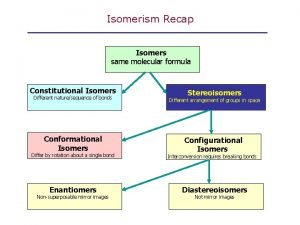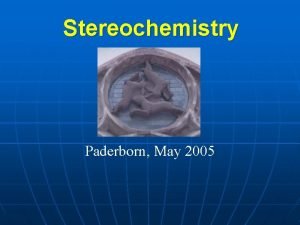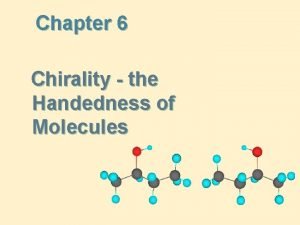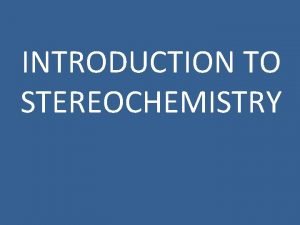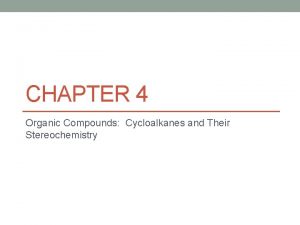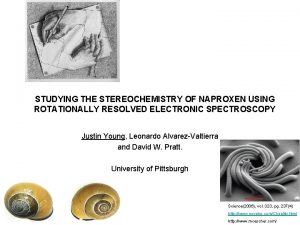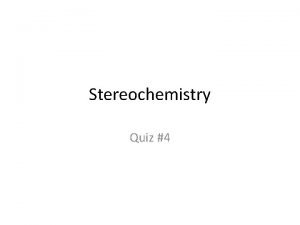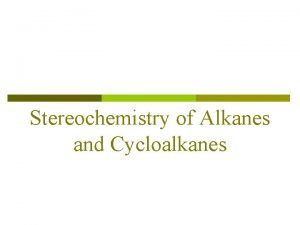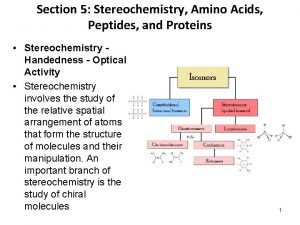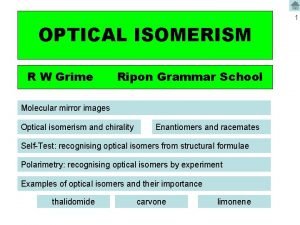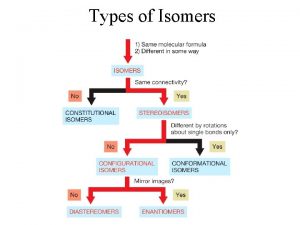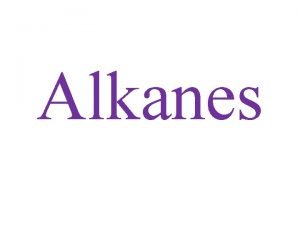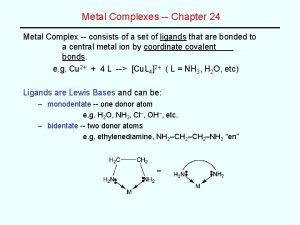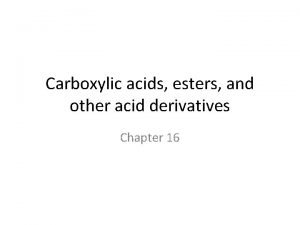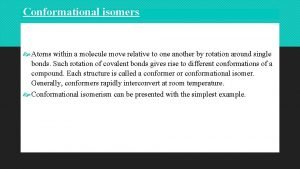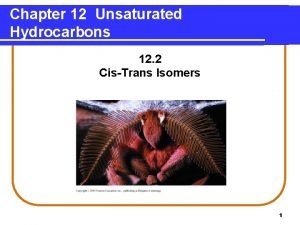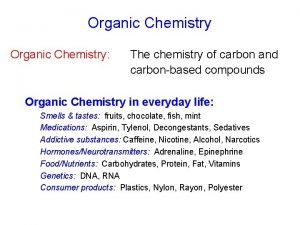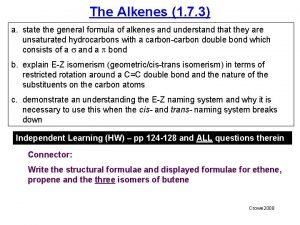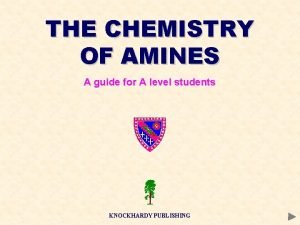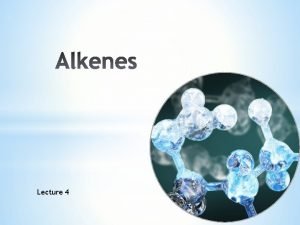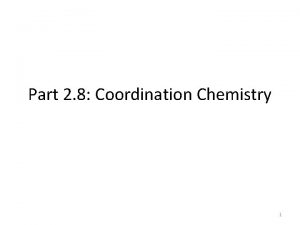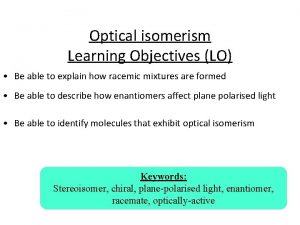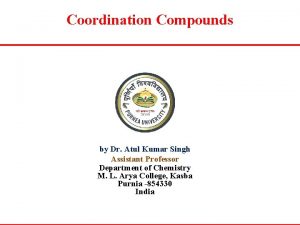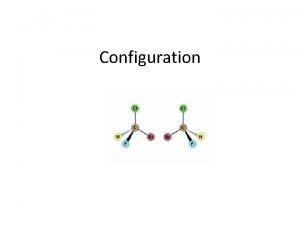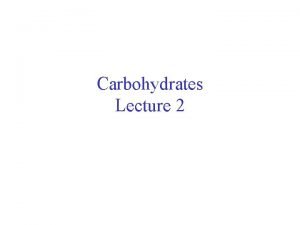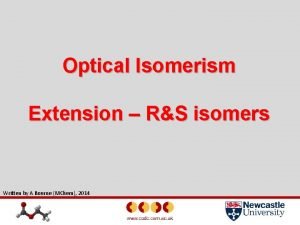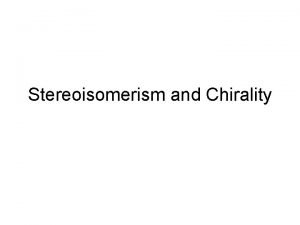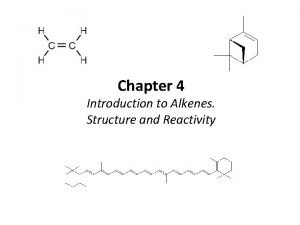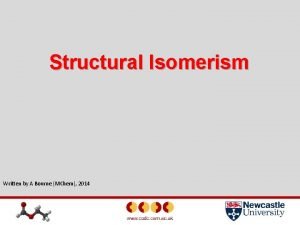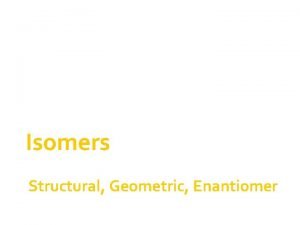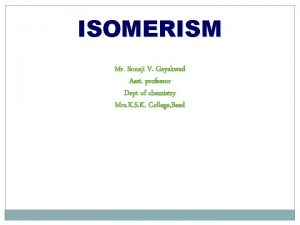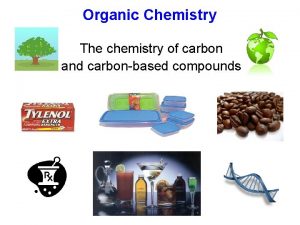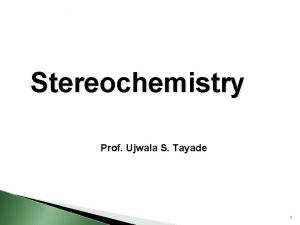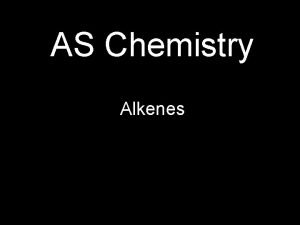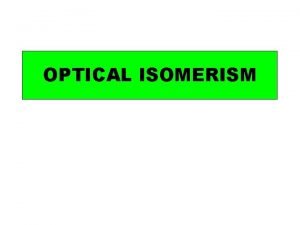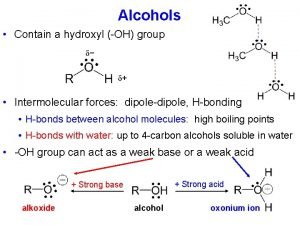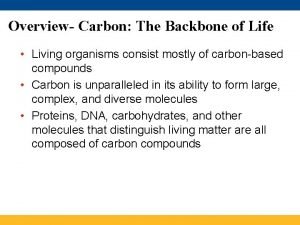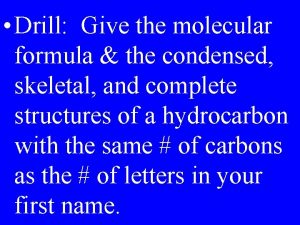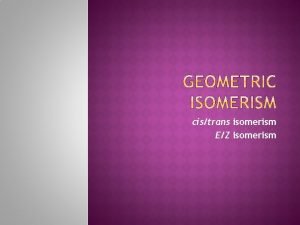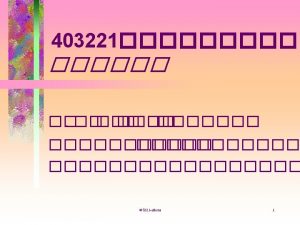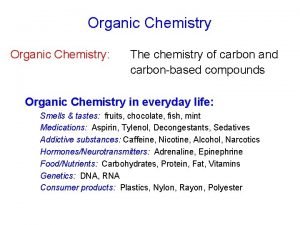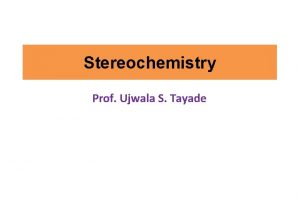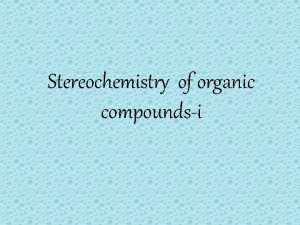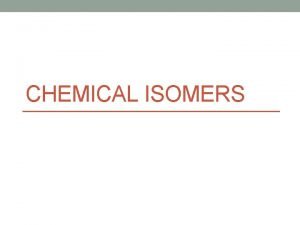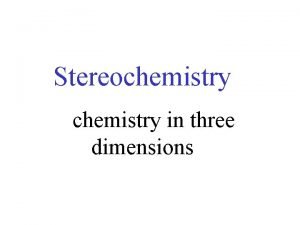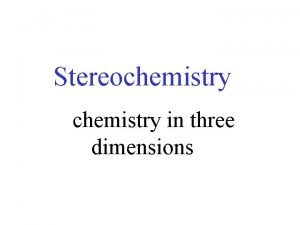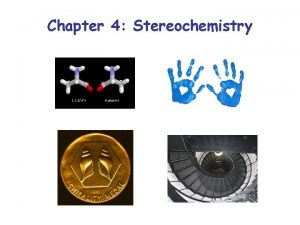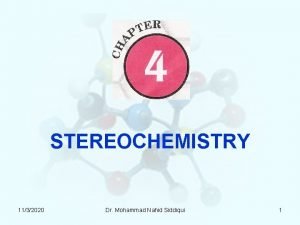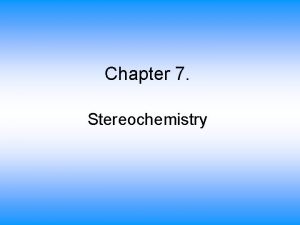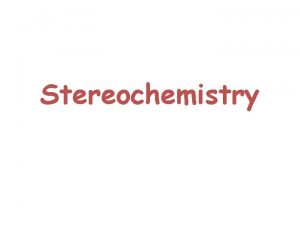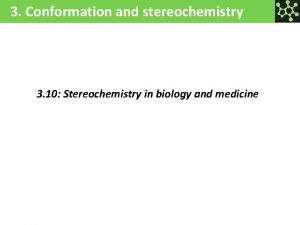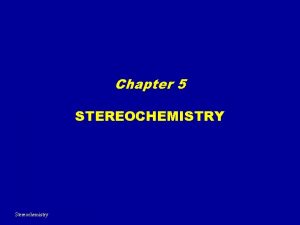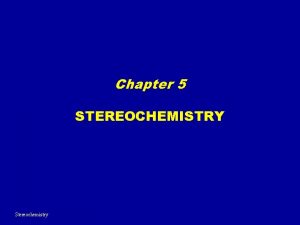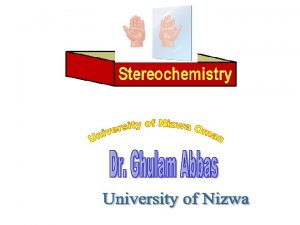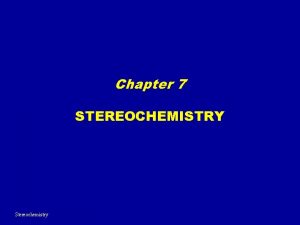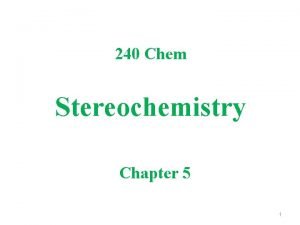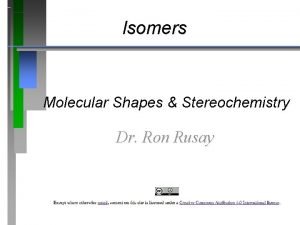Stereochemistry Prof Ujwala S Tayade 1 Isomers different
























































- Slides: 56

Stereochemistry Prof. Ujwala S. Tayade 1

Isomers – different compounds with the same molecular formula. Structural Isomers – isomers that differ in which atoms are bonded to which atoms. CH 3 eg. C 4 H 10 CH 3 CH 2 CH 3 CHCH 3 n-butane isobutane 2

Stereochemistry The Two Major Classes of Isomers: • Recall that isomers are different compounds with the same molecular formula. • The two major classes of isomers are constitutional isomers and stereoisomers. Constitutional/structural isomers have different IUPAC names, the same or different functional groups, different physical properties and different chemical properties. Stereoisomers differ only in the way the atoms are oriented in space. They have identical IUPAC names (except for a prefix like cis or trans). They always have the same functional group(s). • A particular three-dimensional arrangement is called a configuration. Stereoisomers differ in configuration. 3

Stereoisomers – isomers that differ in the way the atoms are oriented in space, but not in which atoms are bonded to which atoms. eg. cis-2 -butene trans-2 -butene 4

Stereochemistry A comparison of consitutional isomers and geometric stereoisomers Stereoisomers may be geometric (cis/trans) or optical. Optical isomers are chiral and exhibit optical activity. 5

Stereochemistry Chiral and Achiral Molecules: • Although everything has a mirror image, mirror images may or may not be superimposable. • A molecule or object that is superimposable on its mirror image is said to be achiral (lacking-chirality). • A molecule or object that is not superimposable on its mirror image is said to be chiral. • Generally, a chiral carbon atom is sp 3 with four different attachments. 6

Stereochemistry Chiral and Achiral Molecules: • Some molecules are like hands. Left and right hands are mirror images, but they are not identical, or superimposable. 7

Stereochemistry Chiral and Achiral Molecules: • We can now consider several molecules to determine whether or not they are chiral. 8

Stereochemistry Chiral and Achiral Molecules: • A carbon atom with four different groups is a chiral center. • The case of 2 -butanol. A and its mirror image labeled B are not superimposable. Thus, 2 -butanol is a chiral molecule and A and B are isomers. • Non-superimposable mirror image stereoisomers like A and B are called enantiomers. 9

Stereochemistry Chiral and Achiral Molecules: • In general, a molecule with no stereogenic centers will not be chiral. There are exceptions to this. • With one stereogenic center, a molecule will always be chiral. • With two or more stereogenic centers, a molecule may or may not be chiral. • Achiral molecules usually contain a plane of symmetry but chiral molecules do not. • A plane of symmetry is a mirror plane that cuts the molecule in half, so that one half of the molecule is a reflection of the other half. 10

Stereochemistry Chiral and Achiral Molecules: Two identical attachments on an sp 3 carbon atom eliminates the possibility of a chiral center. 11

Stereochemistry Summary of the Basic Principles of Chirality • Everything has a mirror image. The fundamental question is whether the molecule and its mirror image are superimposable. • If a molecule and its mirror image are not superimposable, the molecule and its mirror image are chiral. • The presence of a plane of symmetry makes a molecule achiral. 12

Stereochemistry Stereogenic Centers: • To locate a stereogenic center, examine each tetrahedral carbon atom in a molecule, and look at the four groups— not the four atoms—bonded to it. • Always omit from consideration all C atoms that cannot be tetrahedral stereogenic centers. These include CH 2 and CH 3 groups Any sp or sp 2 hybridized C 13

Stereochemistry Identifying of Stereogenic Centers: • Larger organic molecules can have two, three or even hundreds of stereogenic centers. 14

Stereochemistry Drawing Stereogenic Centers - the wedge diagram: • To draw both enantiomers of a chiral compound such as 2 -butanol, use the typical convention for depicting a tetrahedron: place two bonds in the plane, one in front of the plane on a wedge, and one behind the plane on a dash. Then, to form the first enantiomer, arbitrarily place the four groups—H, OH, CH 3 and CH 2 CH 3—on any bond to the stereogenic center. Then draw the mirror image. 15

Stereochemistry Drawing Stereogenic Centers - the wedge diagram: Three-dimensional representations for pairs of enantiomers 16

Stereochemistry Identifying of Stereogenic Centers: • Stereogenic centers may also occur at carbon atoms that are part of a ring. • To find stereogenic centers on ring carbons, always draw the rings as flat polygons, and look for tetrahedral carbons that are bonded to four different groups. Contains a plane of symmetry 17

Stereochemistry Drawing Stereogenic Centers - the wedge diagram: • In 3 -methylcyclohexene, the CH 3 and H substituents that are above and below the plane of the ring are drawn with wedges and dashes as usual. 18

Stereochemistry Identifying of Stereogenic Centers: • Identify the chiral carbons in the compounds below. 19

Stereochemistry Drawing Stereogenic Centers – the Fischer Projection: • In a Fischer projection of a chiral carbon and its mirror image: horizontal bonds project toward the viewer and vertical bonds project away from the viewer. • The test for non-superimposability is to slide on top of the other or rotate 180 o and attempt the same. • Fischer projections of the two enantiomers of 2 -butanol: The chiral carbon atom is at the center of the crossed lines. 20

Stereochemistry Drawing Stereogenic Centers – the Fischer Projection: • Fischer projections of a compound with 2 chiral carbons, (two pairs of enantiomers). • The maximum number of optical isomers is 2 n. (where n = the number of chiral carbon atoms. ) The pairs are diastereomerically related. 21

Stereochemistry Drawing Stereogenic Centers – the Fischer Projection: • However, there may be severa. I different Fischer projections for the same compound depending upon the direction from which is is viewed. Are these structures the same or different ? 22

Stereochemistry Labeling Stereogenic Centers: • The three dimensional arrangement about a tetrahedral carbon atom is referred to as its configuration. • Early workers in the late 1800 s including Fischer used the terms D and L to label the two molecules in a nonsuperimposable mirror image pair. • D and L assignments were chemically related to the structures of glyceraldehyde. • More recently Cahn, Ingold and Prelog developed the R and S system of assignment which is more convenient. 23

Stereochemistry Labeling Stereogenic Centers with R or S: • Since enantiomers are two different compounds, they need to be distinguished by name. This is done by adding the prefix R or S to the IUPAC name of the enantiomer. • Naming enantiomers with the prefixes R or S is called the Cahn-Ingold-Prelog system. • To designate enantiomers as R or S, priorities must be assigned to each group bonded to the stereogenic center, in order of decreasing atomic number. The atom of highest atomic number gets the highest priority (1). 24

Stereochemistry Labeling Stereogenic Centers with R or S: • If two atoms on a stereogenic center are the same, assign priority based on the atomic number of the atoms bonded to these atoms. One atom of higher atomic number determines the higher priority. 25

Stereochemistry Labeling Stereogenic Centers with R or S: • If two isotopes are bonded to the stereogenic center, assign priorities in order of decreasing mass number. Thus, in comparing the three isotopes of hydrogen, the order of priorities is: 26

Stereochemistry Labeling Stereogenic Centers with R or S: • To assign a priority to an atom that is part of a multiple bond, treat a multiply bonded atom as an equivalent number of singly bonded atoms. For example, the C of a C=O is considered to be bonded to two O atoms. • Other common multiple bonds are drawn below: 27

Stereochemistry Labeling Stereogenic Centers with R or S: Figure 5. 6 Examples of assigning priorities to stereogenic centers 28

Stereochemistry Labeling Stereogenic Centers with R or S: 29

Stereochemistry Labeling Stereogenic Centers with R or S: 30

Stereochemistry Labeling Stereogenic Centers with R or S: 31

Stereochemistry Labeling Stereogenic Centers with R or S: Figure 5. 7 Examples: Orienting the lowest priority group in back 32

Stereochemistry Diastereomers: • For a molecule with n stereogenic centers, the maximum number of stereoisomers is 2 n. Let us consider the stepwise procedure for finding all the possible stereoisomers of 2, 3 dibromopentane. 33

Stereochemistry Diastereomers: • If you have drawn the compound and the mirror image in the described manner, you have only to do two operations to see if the atoms align. Place B directly on top of A; and rotate B 180° and place it on top of A to see if the atoms align. • In this case, the atoms of A and B do not align, making A and B nonsuperimposable mirror images—i. e. , enantiomers. Thus, A and B are two of the four possible stereoisomers of 2, 3 -dibromopentane. 34

Stereochemistry Diastereomers: • Switching the positions of H and Br (or any two groups) on one stereogenic center of either A or B forms a new stereoisomer (labeled C in this example), which is different from A and B. The mirror image of C is labeled D. C and D are enantiomers. • Stereoisomers that are not mirror images of one another are called diastereomers. For example, A and C are diastereomers. 35

Stereochemistry Diastereomers: Figure 5. 8 Summary: The four stereoisomers of 2, 3 -dibromopentane 36

Stereochemistry Meso Compounds: • Let us now consider the stereoisomers of 2, 3 -dibromobutane. Since this molecule has two stereogenic centers, the maximum number of stereoisomers is 4. • To find all the stereoisomers of 2, 3 -dibromobutane, arbitrarily add the H, Br, and CH 3 groups to the stereogenic centers, forming one stereoisomer A, and then draw its mirror image, B. 37

Stereochemistry Meso Compounds: • To find the other two stereoisomers if they exist, switch the position of two groups on one stereogenic center of one enantiomer only. In this case, switching the positions of H and Br on one stereogenic center of A forms C, which is different from both A and B. • A meso compound is an achiral compound that contains tetrahedral stereogenic centers. C is a meso compound. 38

Stereochemistry Meso Compounds: • Compound C contains a plane of symmetry, and is achiral. • Meso compounds generally contain a plane of symmetry so that they possess two mirror image halves. • Because one stereoisomer of 2, 3 -dibromobutane is superimposable on its mirror image, there are only three stereoisomers, not four. 39

Stereochemistry Meso Compounds: Figure 5. 9 Summary: The three stereoisomers 2, 3 -dibromobutane 40

Stereochemistry R and S Assignments in Compounds with Two or More Stereogenic Centers. • When a compound has more than one stereogenic center, R and S configurations must be assigned to each of them. One stereoisomer of 2, 3 -dibromopentane The complete name is (2 S, 3 R)-2, 3 -dibromopentane 41

Stereochemistry Disubstituted Cycloalkanes: • Consider 1, 3 -dibromocyclopentane. Since it has two stereogenic centers, it has a maximum of four stereoisomers. • Recall that a disubstituted cycloalkane can have two substituents on the same side of the ring (cis isomer, A) or on opposite sides of the ring (trans isomer, B). These compounds are stereoisomers but not mirror images. 42

Stereochemistry Disubstituted Cycloalkanes: • To find the other two stereoisomers if they exist, draw the mirror images of each compound and determine whether the compound and its mirror image are superimposable. • The cis isomer is superimposable on its mirror image, making the images identical. Thus, A is an achiral meso compound. 43

Stereochemistry Disubstituted Cycloalkanes: • The trans isomer is not superimposable on its mirror image, labeled C, making B and C different compounds. B and C are enantiomers. • Because one stereoisomer of 1, 3 -dibromocyclopentane is superimposable on its mirror image, there are only three stereoisomers, not four. 44

Stereochemistry Figure 5. 10 Summary—Types of isomers 45

Stereochemistry Figure 5. 11 Determining the relationship between two nonidentical molecules 46

Stereochemistry Optical Activity • The chemical and physical properties of two enantiomers are identical except in their interaction with chiral substances. • The physical property that differs is the behavior when subjected to plane-polarized light ( this physical property is often called an optical property). • Plane-polarized (polarized) light is light that has an electric vector that oscillates in a single plane. • Plane-polarized light arises from passing ordinary light through a polarizer. 47

Stereochemistry Optical Activity • Originally a natural polarizer, calcite or iceland spar, was used. Today, polarimeters use a polarized lens similar to that used in some sunglasses. • A polarizer has a very uniform arrangement of molecules such that only those light rays of white light (which is diffuse) that are in the same plane as the polarizer molecules are able to pass through. • A polarimeter is an instrument that allows polarized light to travel through a sample tube containing an organic compound and permits measurement of the degree to which the light is rotated. 48

Stereochemistry Optical Activity • With achiral compounds, the light that exits the sample tube remains unchanged. A compound that does not change the plane of polarized light is said to be optically inactive. 49

Stereochemistry Optical Activity • With chiral compounds, the plane of the polarized light is rotated through an angle . The angle is measured in degrees (°), and is called the observed rotation. A compound that rotates polarized light is said to be optically active. 50

Stereochemistry Optical Activity • The rotation of polarized light can be clockwise or counterclockwise. • If the rotation is clockwise (to the right of the noon position), the compound is called dextrorotatory. The rotation is labeled d or (+). • If the rotation is counterclockwise, (to the left of noon), the compound is called levorotatory. The rotation is labeled l or (-). • Two enantiomers rotate plane-polarized light to an equal extent but in opposite directions. Thus, if enantiomer A rotates polarized light +5°, the same concentration of enantiomer B rotates it – 5°. • No relationship exists between R and S prefixes and the (+) and (-) designations that indicate optical rotation. 51

Stereochemistry Racemic Mixtures • An equal amount of two enantiomers is called a racemic mixture or a racemate. A racemic mixture is optically inactive. Because two enantiomers rotate plane-polarized light to an equal extent but in opposite directions, the rotations cancel, and no rotation is observed. 52

Stereochemistry Racemic Mixtures • Specific rotation is a standardized physical constant for the amount that a chiral compound rotates planepolarized light. Specific rotation is denoted by the symbol [ ] and defined using a specific sample tube length (l, in dm), concentration (c in g/m. L), temperature (250 C) and wavelength (589 nm). 53

Stereochemistry Enantiomeric excess and Optical purity: ee and op • Enantiomeric excess (ee) is a measurement of the excess of one enantiomer over the racemic mixture. ee = % of one enantiomer - % of the other enantiomer. • Consider the following example: If a mixture contains 75% of one enantiomer and 25% of the other, the enantiomeric excess is 75% - 25% = 50%. Thus, there is a 50% excess of one enantiomer over the racemic mixture. • ee is numerically equal to Optical Purity. • The optical purity can be calculated if the specific rotation [ ] of a mixture and the specific rotation [ ] of a pure enantiomer are known. op = ([ ] mixture/[ ] pure enantiomer) x 100. 54

Stereochemistry Physical Properties of Stereoisomers: • Since enantiomers have identical physical properties, they cannot be separated by common physical techniques like distillation. • Diastereomers and constitutional isomers have different physical properties, and therefore can be separated by common physical techniques. Figure 5. 12 The physical properties of the three stereoisomers of tartaric acid. 55

Stereochemistry Chemical Properties of Enantiomers: • Two enantiomers have exactly the same chemical properties except for their reaction with chiral non-racemic reagents. • Many drugs are chiral and often must react with a chiral receptor or chiral enzyme to be effective. One enantiomer of a drug may effectively treat a disease whereas its mirror image may be ineffective or toxic. 56
 Difference between enantiomers and diastereomers
Difference between enantiomers and diastereomers Father of stereochemistry
Father of stereochemistry Stereochemistry of cephalosporins
Stereochemistry of cephalosporins R vs s stereochemistry
R vs s stereochemistry Introduction to stereochemistry
Introduction to stereochemistry Introduction to stereochemistry
Introduction to stereochemistry Cyclopentane cis trans isomers
Cyclopentane cis trans isomers Stereochemistry
Stereochemistry Stereochemistry quiz
Stereochemistry quiz Stability of chair and boat conformation
Stability of chair and boat conformation What is protein
What is protein Isomers
Isomers Nonsuperimposible
Nonsuperimposible All isomers of hexane
All isomers of hexane Coordination isomers
Coordination isomers Butyl isomers
Butyl isomers Diacetylferrocene isomers
Diacetylferrocene isomers Carboxylic acid to ester
Carboxylic acid to ester Conformational isomerism
Conformational isomerism Cis trans isomers
Cis trans isomers Alkyl substituents
Alkyl substituents E and z notation
E and z notation 3-methylhexane optical isomers
3-methylhexane optical isomers Chemistry organic
Chemistry organic Physical properties of amines
Physical properties of amines Geometrical isomers
Geometrical isomers Spectrochemical series
Spectrochemical series Propenenol
Propenenol Isomers of mabcd
Isomers of mabcd Interconvertable
Interconvertable L isomer
L isomer Optical isomerism worksheet
Optical isomerism worksheet What is a constitutional isomer
What is a constitutional isomer Cahn ingold prelog rules
Cahn ingold prelog rules Diacetylferrocene isomers
Diacetylferrocene isomers C5h12 structural isomers
C5h12 structural isomers Structural geometric and enantiomer isomers
Structural geometric and enantiomer isomers Difference between structural and geometric isomers
Difference between structural and geometric isomers 2-ethylpentane
2-ethylpentane Consitutional isomers
Consitutional isomers M(ab)3 isomers
M(ab)3 isomers But-2-ene isomers
But-2-ene isomers Isomers mirror image
Isomers mirror image Butyl isomers
Butyl isomers Ethyl propyl ether structure
Ethyl propyl ether structure What is structural isomerism
What is structural isomerism C8h18 isomers
C8h18 isomers E z cis trans
E z cis trans 403221
403221 Structure name
Structure name Technicolor test
Technicolor test Different angle different story
Different angle different story Venn diagram different same different
Venn diagram different same different Sound will travel at different speeds in different mediums.
Sound will travel at different speeds in different mediums. Acids and bases song
Acids and bases song Library.thinkquest.org 19537
Library.thinkquest.org 19537 Different materials have different
Different materials have different
